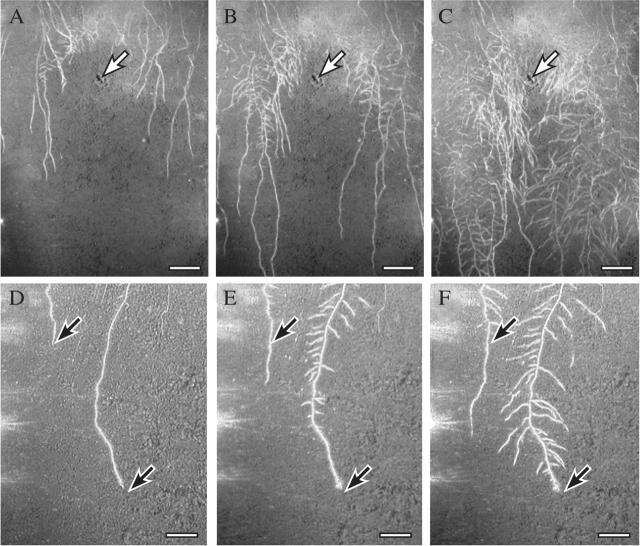Fig. 3.
Images from time-lapse movies of wheat roots growing in a rhizobox (10 × 25 × 50 mm) with field soil, taken with green light from diodes and a Nikon Coolpix 5400 digital camera. (A–C) Roots responding to a patch of anhydrous ammonia. One day prior to sowing seeds (five seeds along the top), ammonia (1 mL of 14 m solution) was injected into the soil at the position indicated by the arrow. The ammonia diffused approximately 50 mm from the centre within minutes of injection, and the soil was very alkaline. (A) Image at 13 d after sowing seeds and 9 d after seminal axes in the middle of the box had reached the upper border of the N patch. Seminal axes on the sides grew past the patch. (B) Image taken 5 d after (A), and branch roots from the seminal axes that were inhibited by the ammonia have started to grow into the patch. Note that their tips are directed downwards, while branch roots from the uninhibited axes on the sides tended to grow more horizontally with weaker gravitropic responses. (C) Image taken 8 d after (A). Branch roots have almost completely filled the area of the nitrogen patch. Rate of growth of seminal roots along the edges was 20 mm d−1; branch roots from these axes approx. 6 mm d−1 and branch roots growing through the patch approx. 11 mm d−1. See Wetselaar et al. (1972) for nitrogen reactions. (D–F) Different movie to (A–C), without an N patch. Two seminal axes of wheat, and 2 d between images. Arrows indicate the tips of the axes; axis on the left is elongating 12 mm d−1; axis on the right is impeded by something in the soil, and branch roots emerge closer and closer to the tip. Scale bar = 50 mm for A–B; 18 mm for D–F.

